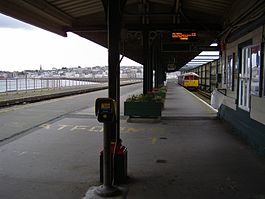Ryde Pier Head railway station
| Ryde Pier Head |
|
|---|---|
 |
|
| Location | |
| Place | Ryde |
| Local authority | Isle of Wight |
| Grid reference | SZ593935 |
| Operations | |
| Station code | RYP |
| Managed by | Island Line Trains |
| Number of platforms | 1 |
| DfT category | E |
| Live arrivals/departures, station information and onward connections from National Rail Enquiries |
|
| Annual rail passenger usage* | |
| 2011/12 |
|
| 2012/13 |
|
| 2013/14 |
|
| 2014/15 |
|
| 2015/16 |
|
| History | |
| Key dates | Opened 12 July 1880 |
| National Rail – UK railway stations | |
| * Annual estimated passenger usage based on sales of tickets in stated financial year(s) which end or originate at Ryde Pier Head from Office of Rail and Road statistics. Methodology may vary year on year. | |
|
|
|
Ryde Pier Head railway station is one of three stations in the town of Ryde on the Isle of Wight. Situated at the end of the town's pier, it is adjacent to the terminal for the Wightlink fast catamaran service connecting the island with Portsmouth on the UK mainland. Passengers can use this to connect with the rest of the National Rail network at Portsmouth Harbour station, which is adjacent to the Portsmouth terminal. Through rail tickets for travel via Pier Head station are available to and from other stations on the Isle of Wight. These include travel on the catamaran service to or from Portsmouth as appropriate.
Trains run down the eastern coast of the Isle of Wight to Shanklin (the Island Line), the last remnant of a network of railways on the island. Because of the restricted loading gauge, particularly through the tunnel under Ryde, services are operated by Class 483s ().
The ticket office at the station is run by Wightlink and not Island Line Trains.
In 1880 the London and South Western Railway (LSWR) and London, Brighton and South Coast Railway (LBSCR) agreed to open a jointly-owned line north from Ryde St John's Road. Under the direction of LBSCR Chief Engineer Frederick Banister, the construction of the extension included a new tunnel and a third Ryde Pier to enable the line to reach a new station at Ryde Pier Head, which provided a connection with the companies' ferry services.
...
Wikipedia
